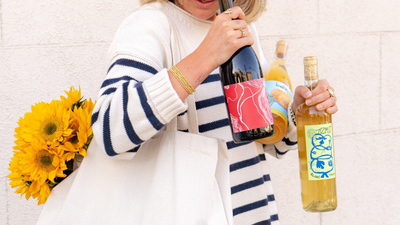While Moselle is one of the newest AOCs in France, having received the status only in 2011, the history of this small AOC in the Lorraine IGP—based around the cities of Metz and Nancy in the northeast, bordered by Alsace to the east and Luxembourg and Germany to the north—dates back to Gallo-Roman times. Defined by the foothills of the Vosges Mountains and a series of river valleys based around the Meuse, Ornain, and Moselle Rivers, this cool continental climate has been prized for its vineyards since 276 AD, when Emperor Probus issued an edict authorizing vine cultivation in northern Gaul, and the entire Metz region became known for its vineyards. The influence of the Moselle vineyards continued throughout the Middle Ages, as abbeys, religious institutions, and lordships regularly purchased Moselle wines. With Louis XIV’s revocation of the Edict of Nantes—originally put in place by Henry IV in 1598 to grant some religious and political protection for the Calvinist-Protestant Huguenots—vineyards were abandoned by the largely Protestant landowners, and the land was divided up by lottery; the Parliament of Metz was staffed with people of Burgundian origin who continued overseeing the vineyards. By the beginning of the 19th century, the region was known for its Pinot Noir, which was prized for its use in sparkling wine. By midcentury, industrialization and urbanization threatened vineyards as land was used for further development, though tenant farmers and sharecroppers kept the vineyards alive, going into debt to buy back vineyards. The region was thrown into further turmoil with the annexation of the Moselle by Germany following the Franco-Prussian War, with German merchants using the fruit from the vineyards to make Sekt. By the eve of the Moselle’s return to France in 1893, it was on the verge of becoming a “second Champagne,” with Roederer & Co. sourcing grapes from Longeville-lès-Metz and Paille-Laurent from Moulin-Gravelotte. The 20th century brought phylloxera, two world wars, and the establishment of the Champagne AOC, leading to the relocation of large estates—all of which devastated the region. This was exacerbated by large amounts of debt and an individualist streak among many winegrowers: diseased vines were not replanted with grafted vines, and a cooperative was not created to help weather the crisis. By 1986, there were only 10 hectares producing wine in the region.
In 1999, Norbert Molozay and his wife, Marie-Genevieve Molozay, purchased a small estate in the village of Vaux from a librarian who had revived viticulture in the region by planting the first vines on three hectares. Norbert, a Beaujolais native trained in Dijon, was a “flying winemaker”—a traveling consultant working in various cellars and vineyards around the world—with experience in New Zealand, Australia, the U.S., Burgundy, Beaujolais, Alsace, and the Languedoc. Marie-Genevieve, a Metz native whose family had been wine merchants for five generations, is a trained scientist who pivoted to oenology, receiving a degree in Dijon. The two immediately fell in love with the estate—a 16th-century château that had been used for the production of sparkling wine under German rule—and were excited by the potential of the region, with its mix of well-draining marl and limestone soils and its south- and southeast-facing vineyards protecting it from the cool, damp weather coming from the west. They began consolidating parcels (they now own one‑third of the vineyards in the region) and changed agricultural practices, starting organic conversion in 2010 and receiving Demeter certification in 2014, having converted to full biodynamic farming. No animal products are used in the making or bottling of the wine. They make pristine, easy‑drinking wines that will be perfect for your holiday table.
Cheers,
Justin Malesheetz- Wine Buyer Fillmore
|
Chateau de Vaux Molozay 2022 Moselle Pinot Noir Les Hautes Bassières |
|
|
Region / Country of Origin: Vaux, Moselle, FR |
About the winemaking: 100% Pinot Noir from Demeter certified vineyards harvested manually and destemmed. The grapes macerate for three weeks with daily punch downs to extract color, tannins and aromatic compounds from the skins. The processed juice is then blended with the free-run juice and fermented in stainless steel, then aged in a wide range of barrels for 12 months before blending and bottling. Tasting Notes: Pale ruby in the glass with a nose of morello cherry, peony, and slate. Medium bodied with vibrant acidity and silky tannins, this dry pinot is bursting with flavors of fresh herbs and tart cherries with a savory mineral note shining through on the long finish. |
|
Vineyard Manager: Norbert & Marie-Genevieve Molozay |
|
|
Price: $25.99 btl/ $280.69 cs |
|
|
Suggested Food Pairing: Chicken pot pie, coq au vin, mushroom croquettes, Thanksgiving dinner. |
|
|
Chateau de Vaux Molozay 2024 Moselle Blanc Les Gryphées |
|
|
Region / Country of Origin: Vaux, Moselle, FR |
About the winemaking: A blend of 50% Auxerrois, 20% Müller-Thurgau, 20% Pinot Gris, and 10% Gewürtztraminer that goes into a pneumatic press once it arrives from the vineyards and is vinified separately in vats at low temperatures. Tasting Notes: Bright nose of white flowers, grapefruit, and lemon zest. Dry and on the lighter side of medium-bodied with a roundness that is framed with bright acidity, this wine is bursting with flavors of ripe stone and citrus fruit with a long mineral finish. |
|
Winemaker: Norbert & Marie-Genevieve Molozay |
|
|
Price: $23.99 btl/ $259.09 cs |
|
|
Suggested Food Pairing: scallops, chicken fricassee, vegetable terrine, mussels, richer fishes like trout and salmon, pasta with cream based sauces. |
|




